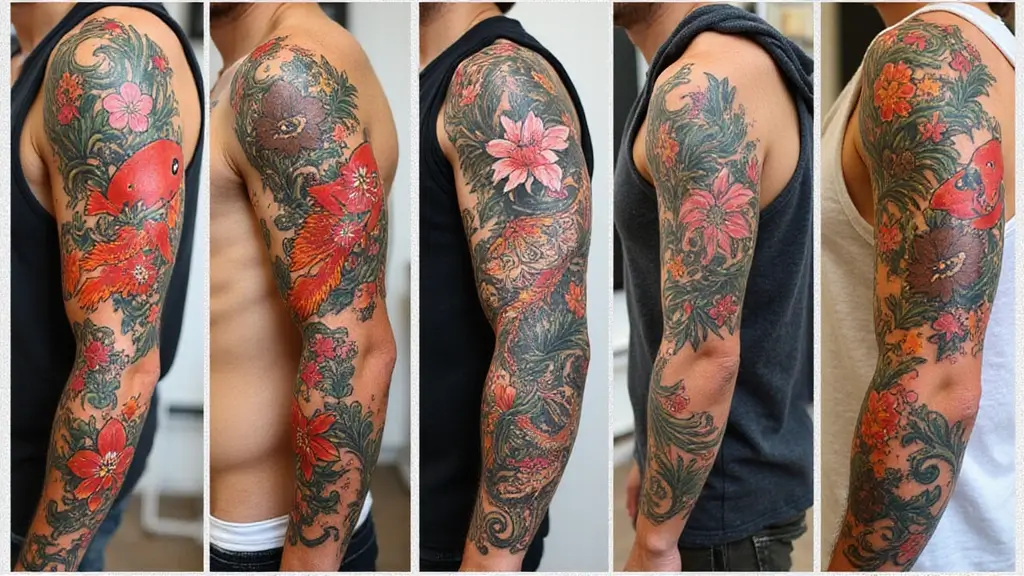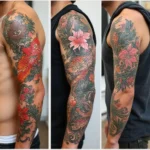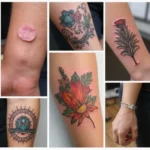Irezumi tattoos, with their vibrant colors and intricate designs, are a stunning tribute to traditional Japanese art. They tell stories of mythology, nature, and personal journeys, all while beautifully adorning the skin. Each tattoo is more than just ink; it’s a cultural emblem representing beauty, strength, and history. Whether you’re drawn to the rich symbolism of koi fish or the fierce appearance of dragons, there’s an Irezumi design that can resonate with anyone.
This list celebrates 30 mesmerizing Irezumi tattoo designs that not only showcase the artistry behind them but also inspire daily habits for glowing skin that complements your body art. Let’s explore these designs and discover how to keep your skin radiant and healthy as you embrace the beauty of Irezumi.
1. Koi Fish: Symbol of Perseverance
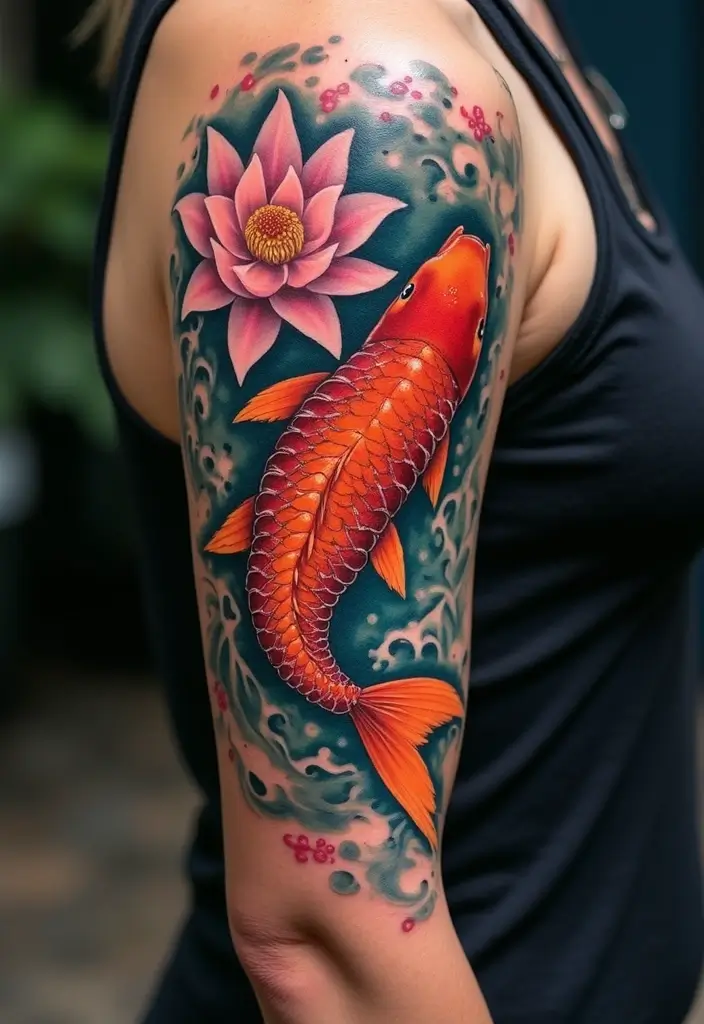
Koi fish tattoos are iconic in Irezumi, symbolizing perseverance and strength. The koi’s journey upstream represents overcoming obstacles, making it a popular choice for those with inspiring stories. These tattoos often feature bright hues of orange and yellow, intertwined with waves and lotus flowers.
For those considering a koi tattoo, think about the placement – the back or arm creates a stunning canvas for this design. Pairing such a bold tattoo with a nourishing skincare routine that emphasizes hydration can keep your skin glowing and complement your body art perfectly.
Here’s how to keep your skin radiant:
– Hydration: Drink plenty of water to maintain skin elasticity.
– Moisturizing: Use a rich moisturizer post-tattoo to soothe the skin.
– Sunscreen: Protect your tattoo with SPF to preserve colors.
This blend of beauty and skin care ensures your koi tattoo remains a vibrant part of your personal story.
2. Dragon: Power and Wisdom
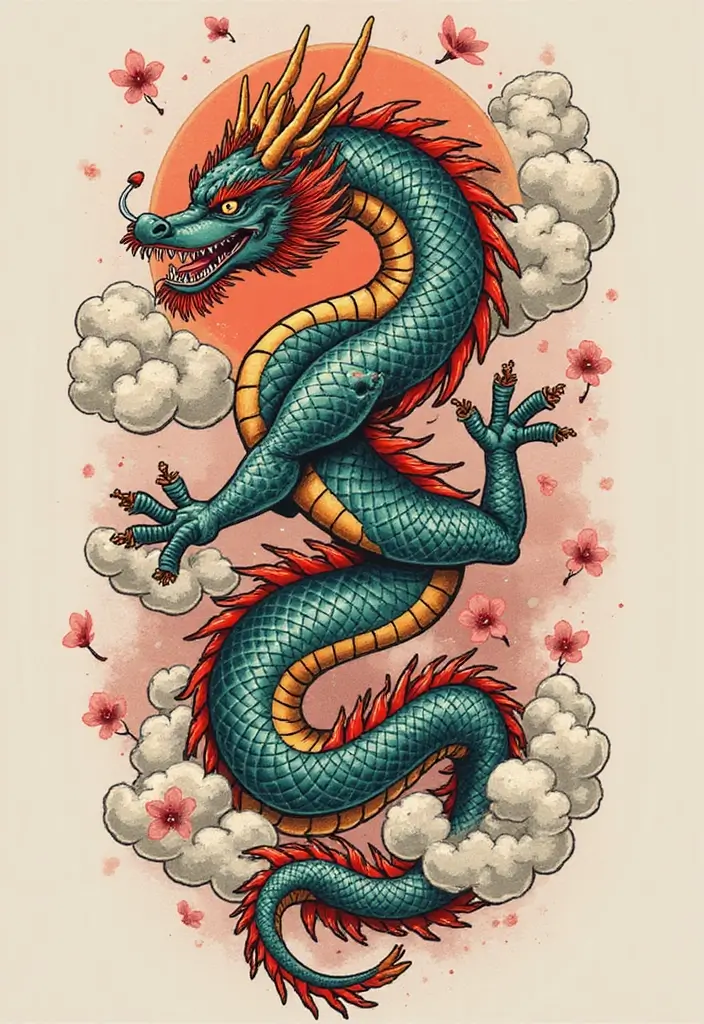
The dragon in Japanese culture embodies power and wisdom, making it a fierce and majestic tattoo option. Irezumi dragons often spiral around the body, with scales detailed in bold colors like deep blues and fiery reds. This tattoo can symbolize protection, strength, and a connection to ancestral heritage.
When considering a dragon design, think about adding elements like clouds or cherry blossoms for a more dynamic look. To ensure your skin remains radiant, consider incorporating daily habits like gentle exfoliation and using serums rich in antioxidants. These practices will help keep your skin fresh and vibrant, making your tattoo pop even more.
Here’s a quick skincare guide:
– Gentle Exfoliation: Use a mild scrub to remove dead skin cells, allowing your tattoo colors to stand out.
– Antioxidant Serums: Apply daily to protect and rejuvenate your skin.
– Professional Care: Visit a dermatologist for personalized advice on tattoo aftercare.
With proper care, your dragon tattoo will not only reflect your inner strength but also enhance your overall beauty.
| Tattoo Design | Symbolism | Skincare Tips |
|---|---|---|
| Koi Fish | Perseverance and strength | Hydration, moisturizing, sunscreen |
| Dragon | Power and wisdom | Gentle exfoliation, antioxidant serums, professional care |
| Cherry Blossoms | Beauty in transience | Hydration, moisturizing routine, sun protection |
| Oni Masks | Embracing duality | Cleansing, moisturization, regular masks |
| Waves | The power of nature | Hydrating products, exfoliation, dietary focus |
| Cranes | Longevity and good fortune | Cleansers, brightening products, sunscreen |
3. Cherry Blossoms: Beauty in Transience
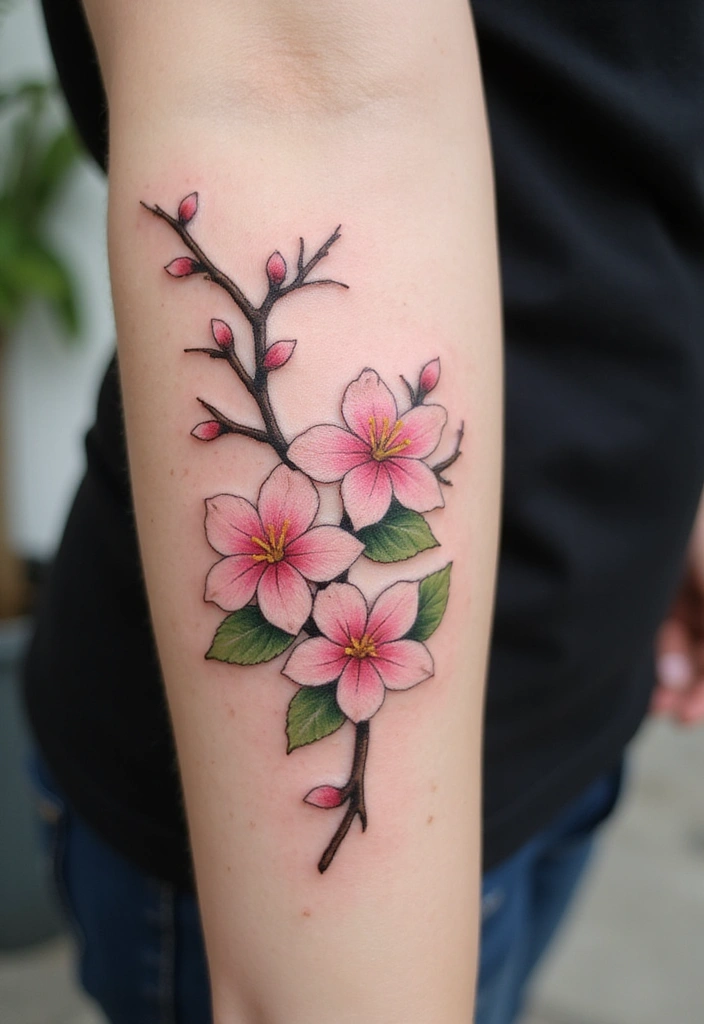
Cherry blossoms, or sakura, are a classic element in Irezumi, symbolizing the beauty of life and its fleeting moments. These delicate flowers often accompany other designs like koi or cranes, adding depth and meaning. The soft pink hues of cherry blossoms can create a stunning contrast against darker tattoos, making them visually captivating.
When planning a cherry blossom tattoo, positioning is key – consider areas where the flowers can flow naturally, like the wrist or ankle. To keep your skin glowing alongside your tattoo, focus on daily moisturizing and nourishing your skin from within with a healthy diet rich in vitamins and minerals.
Here are some tips for skincare:
– Hydration: Incorporate hydrating foods like cucumbers and watermelon.
– Moisturizing Routine: Use lotions with natural ingredients to keep your skin supple.
– Sun Protection: Always apply sunscreen to prevent fading.
With the right skincare, your cherry blossom tattoo can mirror the beauty of your skin, both telling a story of transience and radiance.
4. Oni Masks: Embracing Duality
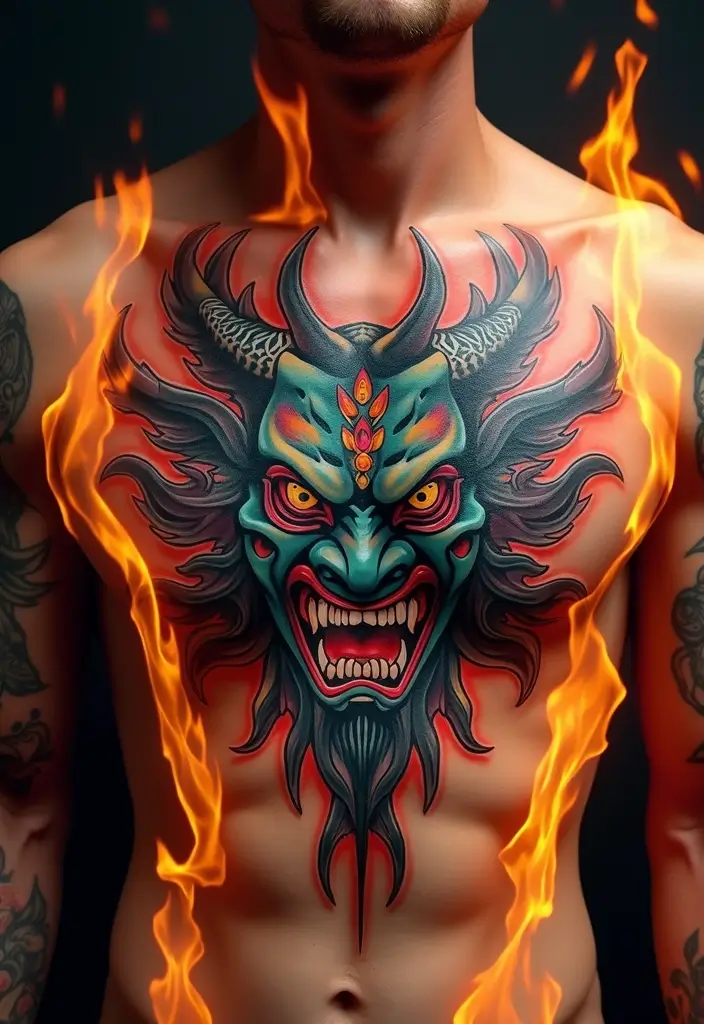
Oni masks are a fascinating choice in Irezumi, representing duality, good, and evil. These tattoos often feature vibrant colors and fierce expressions, making them bold and dramatic. Oni masks can serve as a reminder of one’s inner struggles and triumphs over adversity.
When choosing an Oni mask design, consider incorporating other elements like flames or skulls for added impact. To match the boldness of your tattoo, maintain a glowing complexion with a consistent skincare routine tailored for your skin type. This includes using products that enhance your natural beauty while respecting the artistry of your tattoo.
Key skincare practices include:
– Cleansing: Use a gentle cleanser to keep your skin clean without stripping natural oils.
– Moisturization: Choose a moisturizer with nourishing oils to enhance skin texture.
– Regular Masks: Incorporate hydrating or purifying masks on a weekly basis.
By juxtaposing the fierce Oni mask with radiant skin, you create a harmonious balance that celebrates both art and beauty.
5. Waves: The Power of Nature
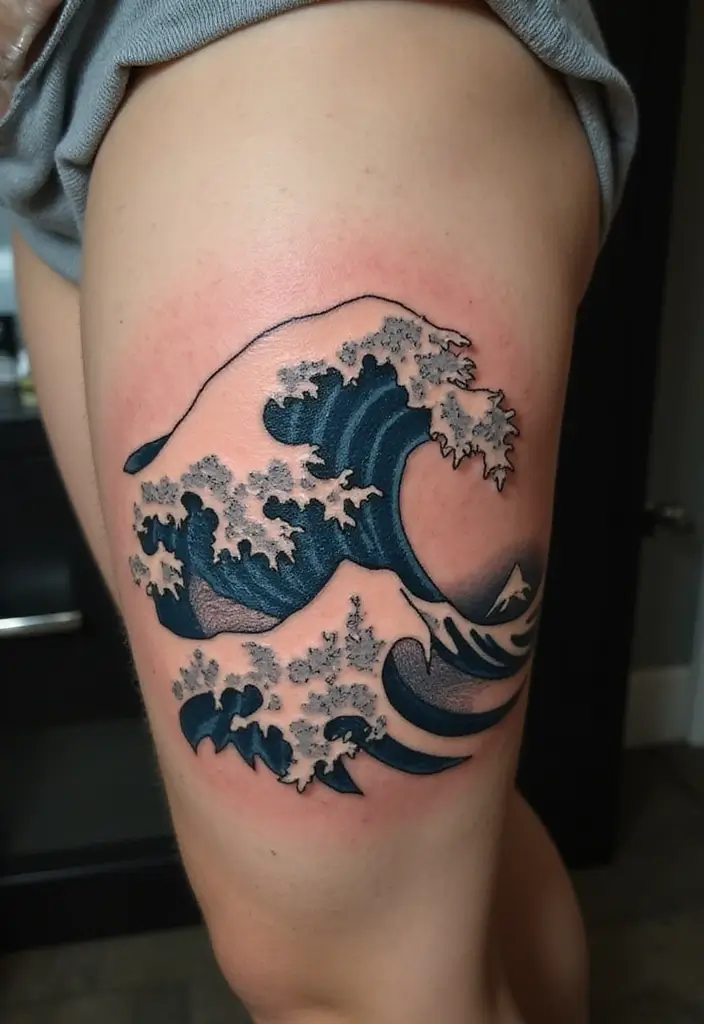
Waves are a fundamental motif in Irezumi, representing strength and the relentless nature of life. These tattoos often feature dynamic lines and can be combined with other elements like koi or cherry blossoms for enhanced storytelling. The movement in wave tattoos can evoke a feeling of freedom and force, making them a popular choice for those who appreciate nature’s power.
For a wave tattoo, consider placement along the arm or back to showcase its flowing nature. Coupled with a solid skincare routine that focuses on hydration and exfoliation, your skin can glow as vibrantly as the waves in your tattoo.
Here’s how to keep your skin luminous:
– Hydrating Products: Use lotions with hyaluronic acid to lock in moisture.
– Exfoliation: Regularly exfoliate to remove dead skin cells and promote cell turnover.
– Dietary Focus: Eat omega-rich foods like salmon for skin health.
The combination of powerful waves and radiant skin showcases a deep connection to nature and personal beauty.
6. Cranes: Longevity and Good Fortune

Cranes hold significant meaning in Japanese culture, symbolizing longevity and good fortune. A crane tattoo can often be depicted in flight, surrounded by elements like clouds or water, creating a serene yet impactful design. The graceful lines and intricate details make cranes a timeless choice for tattoo enthusiasts.
When getting a crane tattoo, think about how it can be positioned to enhance your body’s natural lines, perhaps along the back or on the thigh. To complement this beauty, include skincare habits that focus on maintaining a healthy complexion. Daily routines that emphasize cleansing, moisturizing, and sun protection can ensure your skin remains vibrant and complementary to your ink.
Consider these skincare tips:
– Cleansers: Use cream-based cleansers for hydration.
– Brightening Products: Incorporate Vitamin C serums for a radiant glow.
– Sunscreen: Never skip sunscreen to prevent skin damage.
With a crane tattoo and glowing skin, you embody both longevity and aesthetic harmony.
7. Lotus Flowers: Purity and Rebirth
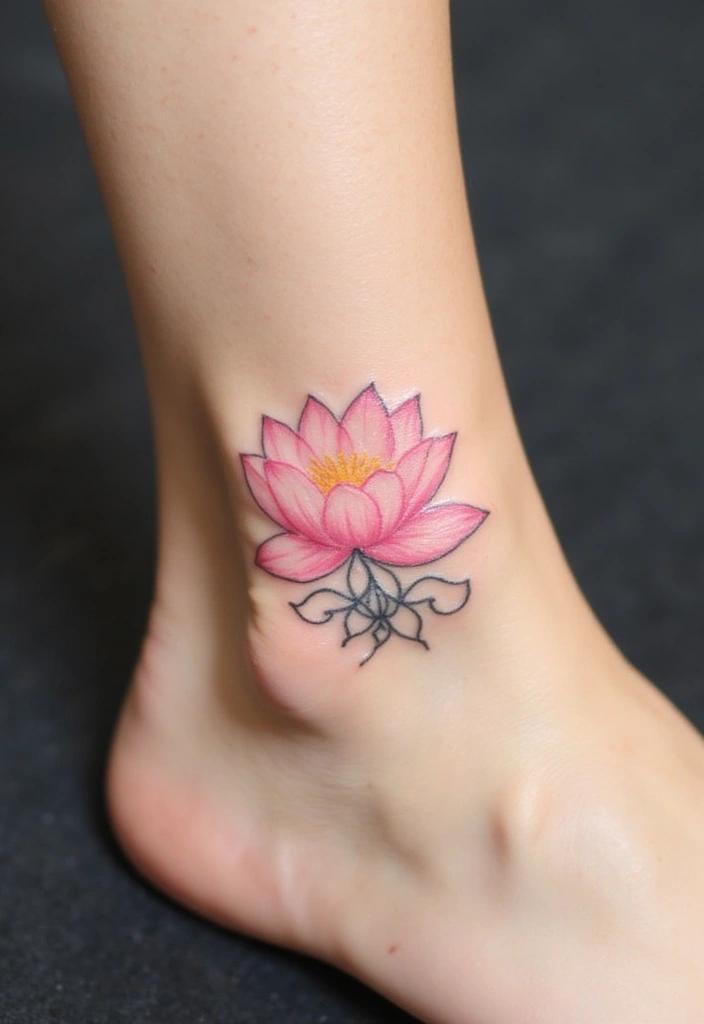
The lotus flower is a powerful symbol in Japanese culture, representing purity, enlightenment, and rebirth. A lotus tattoo often appears in serene colors like soft pink or white, symbolizing the triumph over adversity as the lotus rises from muddy waters. This design can be a deeply personal statement about growth and resilience.
When planning a lotus flower tattoo, consider placing it near areas that allow for intricate detailing, such as the wrist or foot. To keep your skin as radiant as the lotus itself, focus on a natural skincare routine that encourages skin health and vitality. Incorporating products rich in natural ingredients can enhance your skin’s glow.
Key skincare practices include:
– Natural Oils: Use oils like jojoba or coconut to nourish the skin.
– Hydration: Drink herbal teas to enhance skin hydration.
– Gentle Exfoliation: Regularly exfoliate to maintain skin smoothness.
With a lotus tattoo and a glowing complexion, you reflect the beauty of resilience and purity.
8. Samurai: Strength and Honor
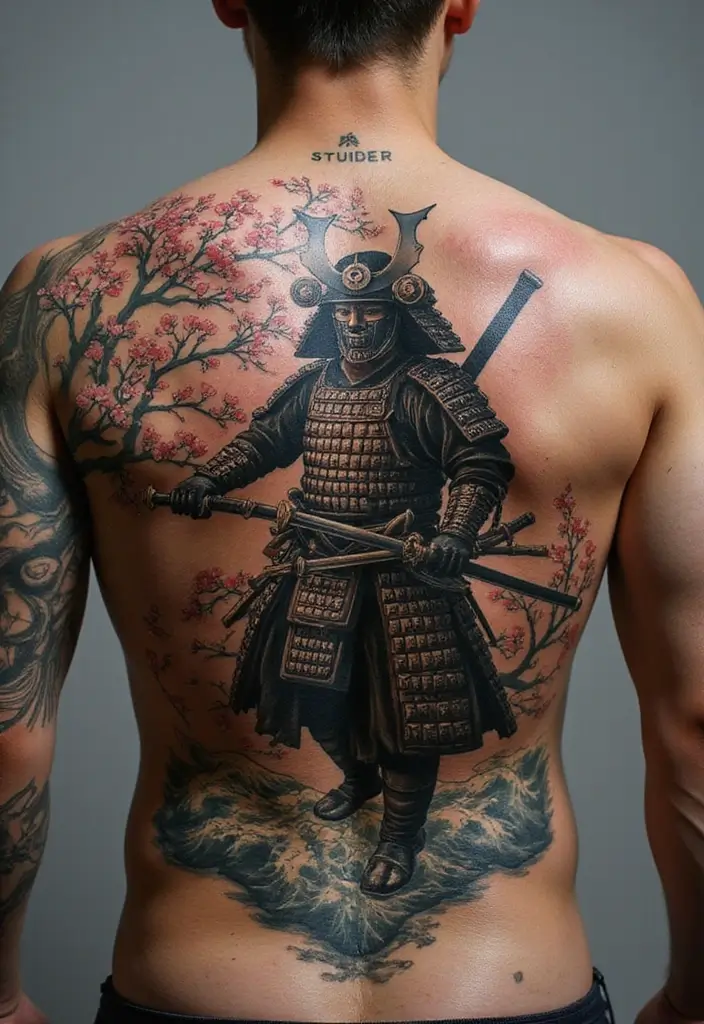
Samurai tattoos encapsulate the fierce spirit of honor, courage, and strength. These designs often depict the warrior in traditional armor, complete with katana and elaborate backgrounds. A samurai tattoo can serve as a reminder of inner strength and resilience, making it an empowering choice for many.
When considering a samurai tattoo, placement is crucial; the back or chest provides ample space to showcase the intricate details. Alongside this bold design, maintain your skin’s radiance by investing time in a skincare regimen that emphasizes rejuvenation and protection. Incorporating elements like retinol can significantly boost skin texture.
Skin care tips for maintaining that warrior glow include:
– Retinol Products: Use retinol to promote cell turnover and minimize fine lines.
– Hydrating Masks: Apply hydrating masks to nourish your skin deeply.
– Consistent Routine: Stick to a skincare routine for maximum effectiveness.
With a samurai tattoo and glowing skin, you portray both strength and thoughtful beauty.
9. Phoenix: Rebirth and Transformation
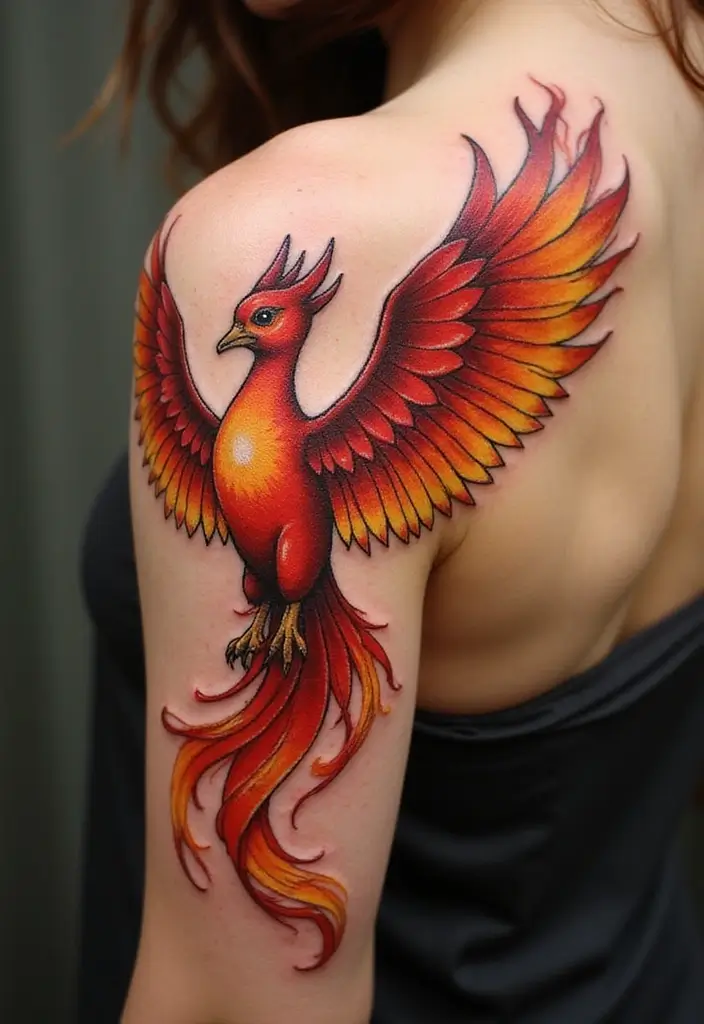
The phoenix, a symbol of rebirth and transformation, is a powerful motif in Irezumi. This mythical bird, often depicted in vibrant reds and golds, signifies overcoming challenges and rising anew. A phoenix tattoo can be a personal emblem of resilience and renewal, making it a favorite among those who have experienced significant life changes.
When choosing a phoenix design, think about flowing lines that mimic the bird’s flight, perfect for placement on the back or shoulder. To complement the fiery nature of your tattoo, incorporate daily habits that promote skin vitality and glow. Using products with alpha-hydroxy acids (AHAs) can help in exfoliating and renewing your skin.
Here are some skincare must-dos:
– Regular Exfoliation: Keep your skin fresh and radiant.
– Brightening Moisturizers: Choose moisturizers with vitamin C for glow.
– Hydration: Never underestimate the power of drinking enough water.
With a phoenix tattoo and glowing skin, you’re a testament to the beauty of transformation.
Embrace the power of the phoenix – a tattoo that embodies resilience and transformation. Let its vibrant wings remind you that every challenge can lead to a beautiful rebirth!
10. Snake: Wisdom and Transformation
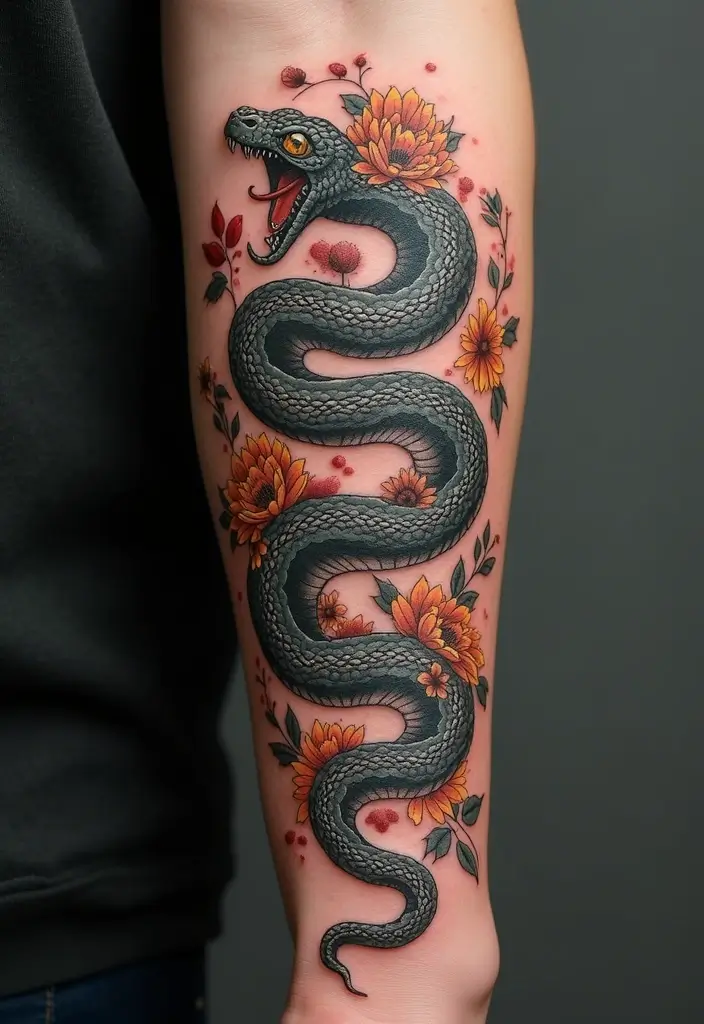
Snake tattoos in Irezumi symbolize wisdom, protection, and transformation. These designs often feature intricately wrapped snakes, sometimes accompanied by other traditional motifs like flowers or skulls. The snake symbolizes shedding the old to make way for the new, resonating deeply with personal growth.
The placement of a snake tattoo can enhance the visual impact, especially when wrapped around the arm or leg. To keep your skin glowing alongside this dynamic design, focus on nutrients that promote skin health. A diet rich in vitamins A, C, and E can significantly benefit your skin’s appearance.
Consider these skincare practices:
– Vitamin-Rich Diet: Incorporate leafy greens and fruits for skin support.
– Hydrating Products: Utilize serums that promote plumpness and hydration.
– Consistent Sun Care: Always wear sunscreen to protect your skin.
A snake tattoo with well-cared-for skin showcases the journey of wisdom and personal evolution.
11. Hannya Mask: Emotions and Duality
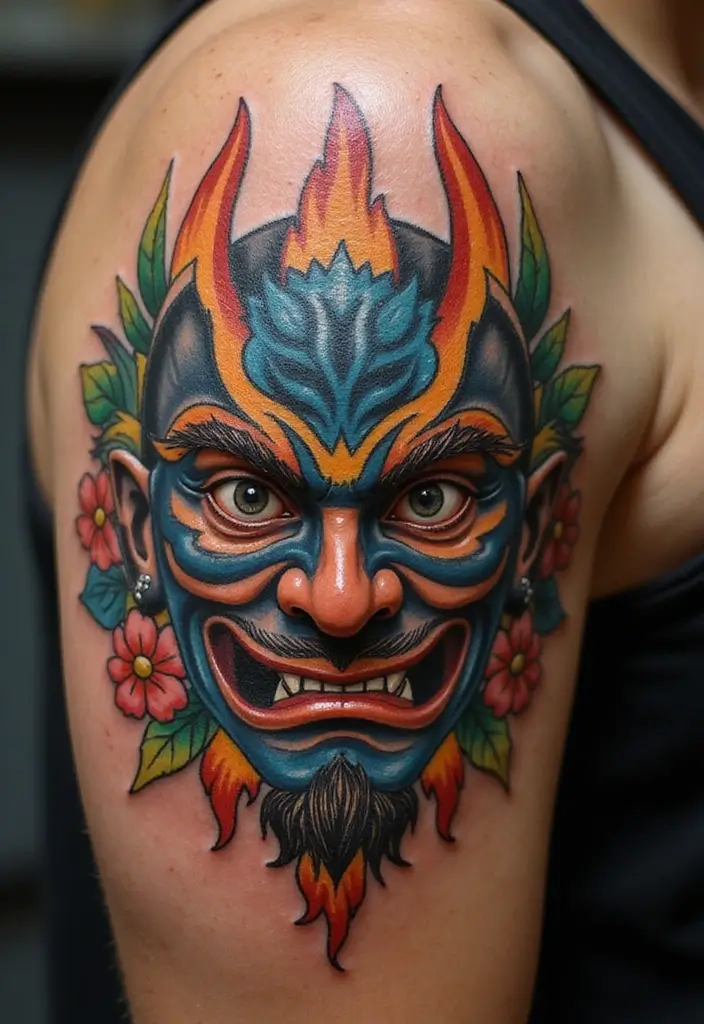
The Hannya mask is a compelling element in Irezumi, signifying the duality of emotions, specifically love and jealousy. This mask represents a woman transformed into a demon due to her unfulfilled desires, making it a powerful symbol of deep human feelings. Hannya tattoos often showcase detailed facial expressions, vibrant colors, and ornate designs, evoking strong reactions.
When considering a Hannya mask tattoo, think about incorporating elements like flowers or flames for a dramatic effect. Complement this striking design with a skincare routine focused on balance and brightness, featuring products that enhance radiance like illuminating serums.
Here’s how to keep your skin glowing:
– Dual Treatment: Use both hydrating and exfoliating products to maintain balance.
– Masking: Incorporate sheet masks into your routine for that extra glow.
– Night Care: Focus on nighttime products that rejuvenate skin overnight.
With a Hannya mask tattoo and bright skin, you reflect the complexity of beauty and emotions.
12. Tiger: Courage and Strength
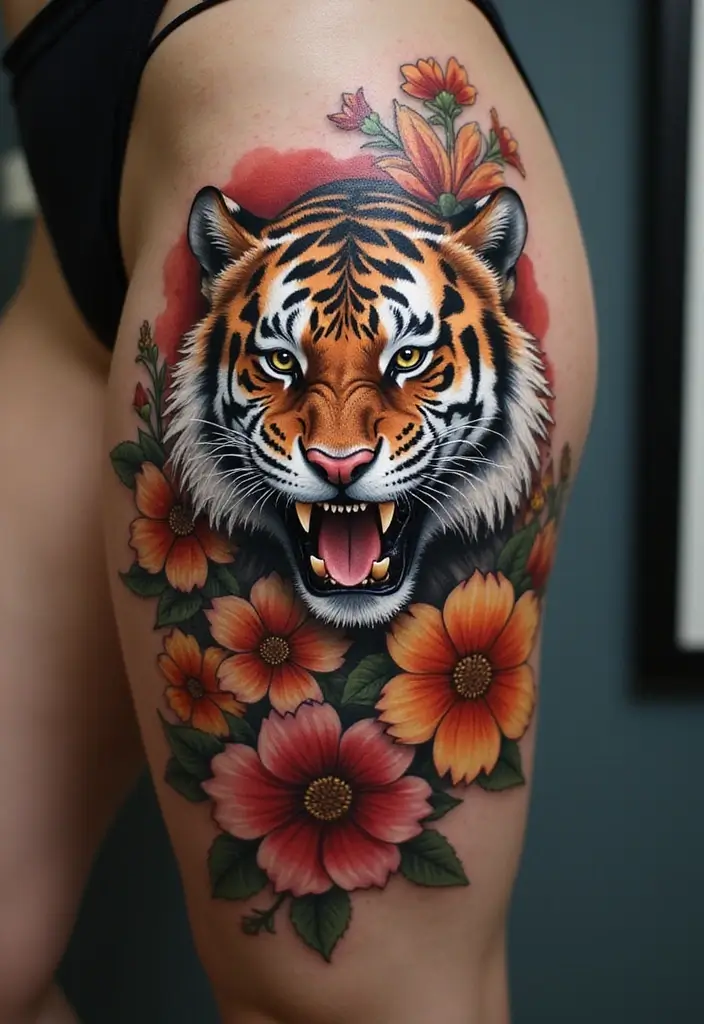
Tiger tattoos are powerful symbols of courage, strength, and protection in Japanese culture. Often depicted mid-roar or prowling through flowers, these tattoos embody a fierce spirit and the beauty of nature. The dynamic design of a tiger tattoo can evoke feelings of empowerment and resilience, making it a popular choice for those seeking bold expressions of personality.
When choosing a tiger tattoo, consider placements like the thigh or back for maximum impact. To ensure your skin remains luminous alongside such a striking design, adopt a skincare routine that includes nourishing products that enhance your natural beauty. Incorporating antioxidant-rich creams can help maintain skin health and glow.
Here are some skincare tips:
– Antioxidants: Look for products that contain vitamins C or E for skin protection.
– Hydration: Drink plenty of water to keep skin looking fresh.
– Regular Care: Establish a routine to promote skin rejuvenation.
With a tiger tattoo and radiant skin, you present a powerful image of strength and beauty.
13. Waves and Koi: Harmony of Strength and Serenity
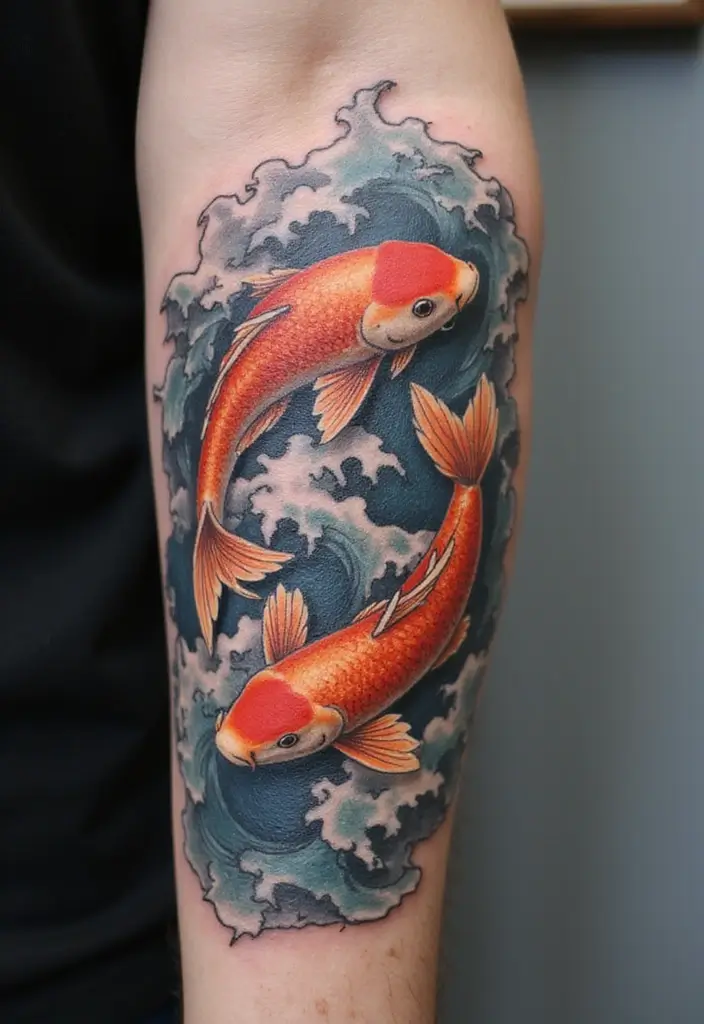
Combining waves and koi fish creates a stunning Irezumi tattoo that symbolizes balance between strength and tranquility. The flowing waves represent life’s challenges, while the koi signifies perseverance in overcoming them. This duality makes for a visually captivating design that tells a powerful story of life’s journey.
When considering this combination, placement along the sleeve or back can enhance the flow of the design. To keep your skin as radiant as the tattoo, focus on a skincare regimen that emphasizes hydration and healing. Regular moisturizing can help maintain a smooth canvas for your ink.
Skin care practices include:
– Hydration: Drink water to keep skin clear and elastic.
– Healing Ointments: Use healing balms post-tattoo for care.
– Moisture-Rich Products: Include products specifically designed for hydration.
With a waves and koi tattoo and a glowing complexion, you exemplify balance and inner peace.
14. Fudo Myoo: Protector and Guardian
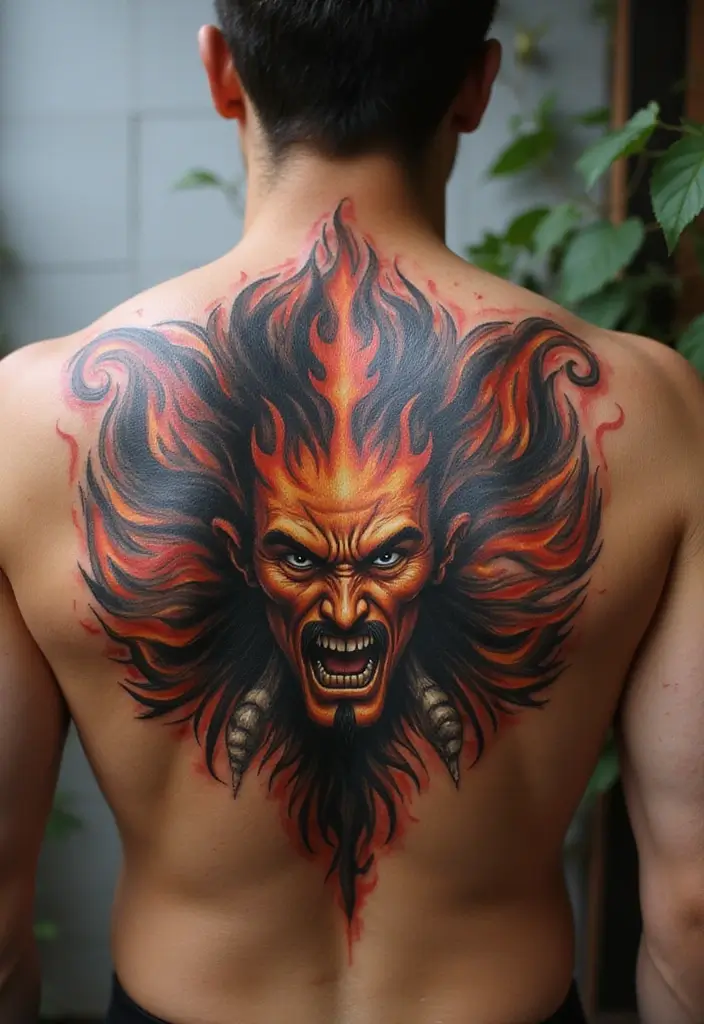
Fudo Myoo, the immovable wisdom king, is a popular tattoo that embodies protection and strength. This design is often characterized by flames and fierce expression, symbolizing the removal of obstacles. A Fudo Myoo tattoo can serve as a powerful talisman for those seeking strength and guidance in their lives.
When getting a Fudo Myoo tattoo, consider how the flames can be depicted to flow naturally with your body’s contours. To enhance your skin’s natural glow, focus on a skincare routine that emphasizes protection, utilizing sunblock and calming products regularly.
Here are some tips for maintaining that protective glow:
– Daily Sunscreen: Protect your skin from UV damage.
– Calming Moisturizers: Use products that soothe and nourish.
– Regular Hydration: Drink plenty of fluids to keep skin hydrated.
With a Fudo Myoo tattoo and a focus on skin health, you can symbolize both inner strength and outer beauty.
15. Peonies: Elegance and Grace
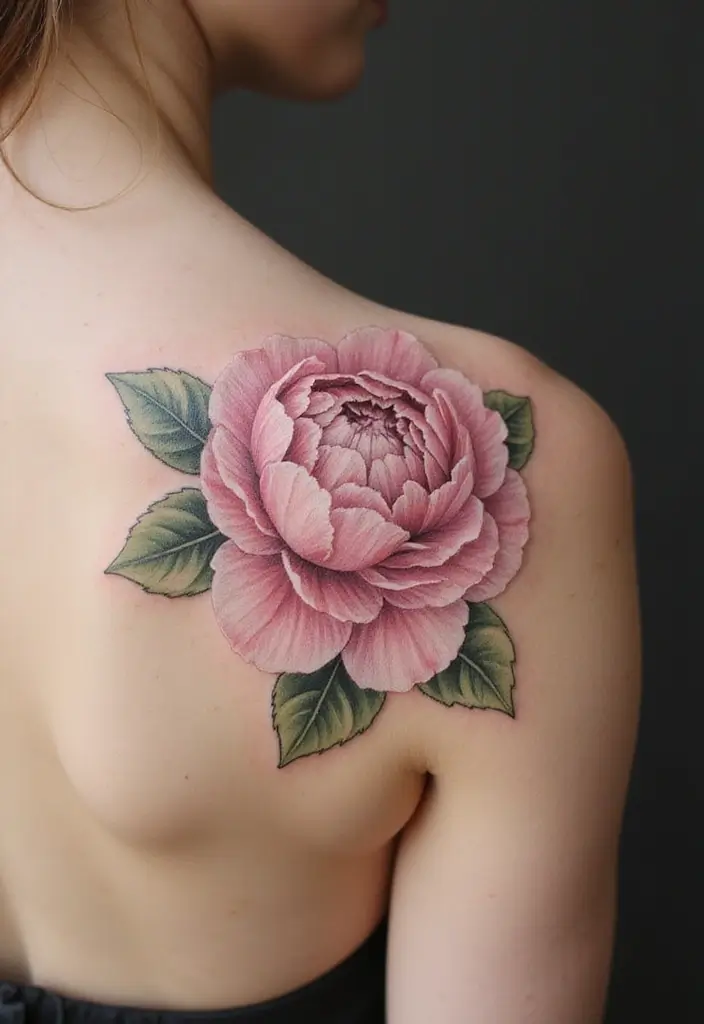
Peonies are a popular choice in Irezumi, symbolizing elegance, grace, and prosperity. These flowers are often incorporated into larger designs, adding a touch of beauty and softness to the boldness of other elements like dragons or koi. Peony tattoos can represent love and honor, making them a favorite among tattoo enthusiasts.
For peony tattoos, consider placement on the shoulder or thigh to highlight their beauty. Alongside such elegant designs, nurture your skin with a routine that enhances its natural radiance. Incorporating floral essences into your skincare can further complement your tattoo.
Skincare tips include:
– Floral Infused Products: Use lotions with floral essences for soothing benefits.
– Hydrating Mists: Keep skin refreshed throughout the day.
– Balanced Diet: Include fruits and vegetables that promote healthy skin.
With a peony tattoo and glowing skin, you present a vision of grace and beauty.
16. Shishi Lions: Symbol of Protection
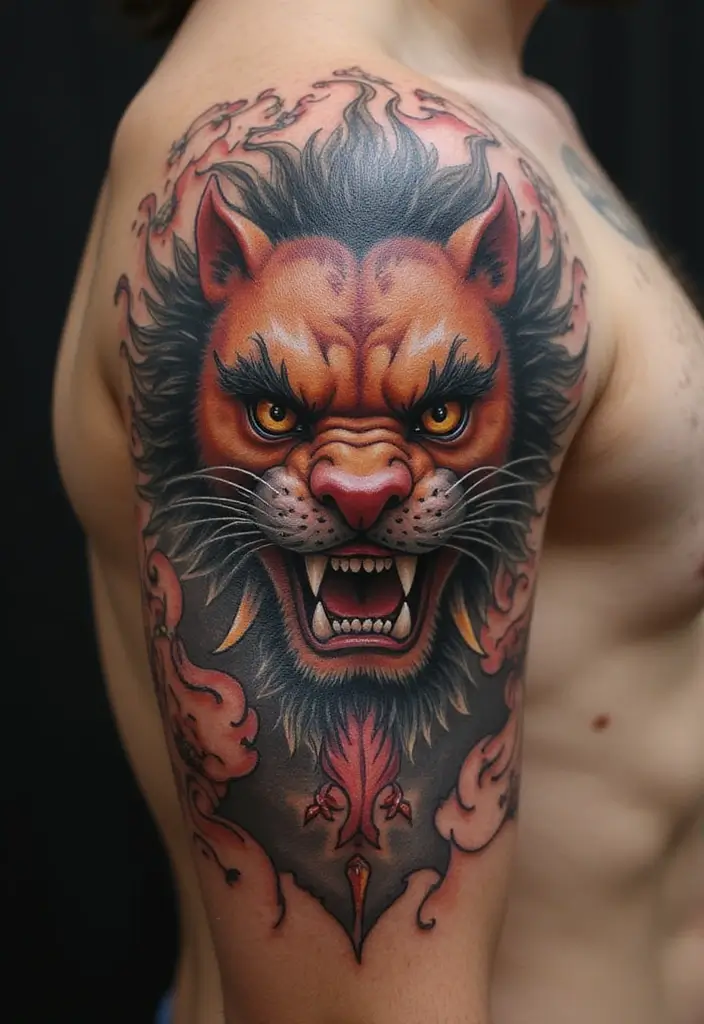
Shishi lions, or guardian lions, are a potent symbol of protection in Japanese culture. Often depicted in pairs, these fierce creatures are said to ward off evil spirits and bring good fortune. A Shishi lion tattoo can represent strength and guardianship, making it an empowering choice.
When choosing a Shishi lion tattoo, consider placement where both lions can be showcased, such as the back or upper arm. To enhance your skin’s glow with this protective tattoo, focus on maintaining a clean and hydrated complexion. Regular cleansing and moisturizing can help create a clear backdrop for your guardian lions.
Here are some skincare practices to consider:
– Deep Cleansing: Use products that deeply cleanse while being gentle.
– Hydrating Creams: Employ rich creams that lock in moisture.
– Regular Exfoliation: Ensure your skin is smooth and ready for display.
With Shishi lions inked and radiant skin, you encompass both protection and beauty.
17. Samurai and Cherry Blossoms: Strength and Beauty
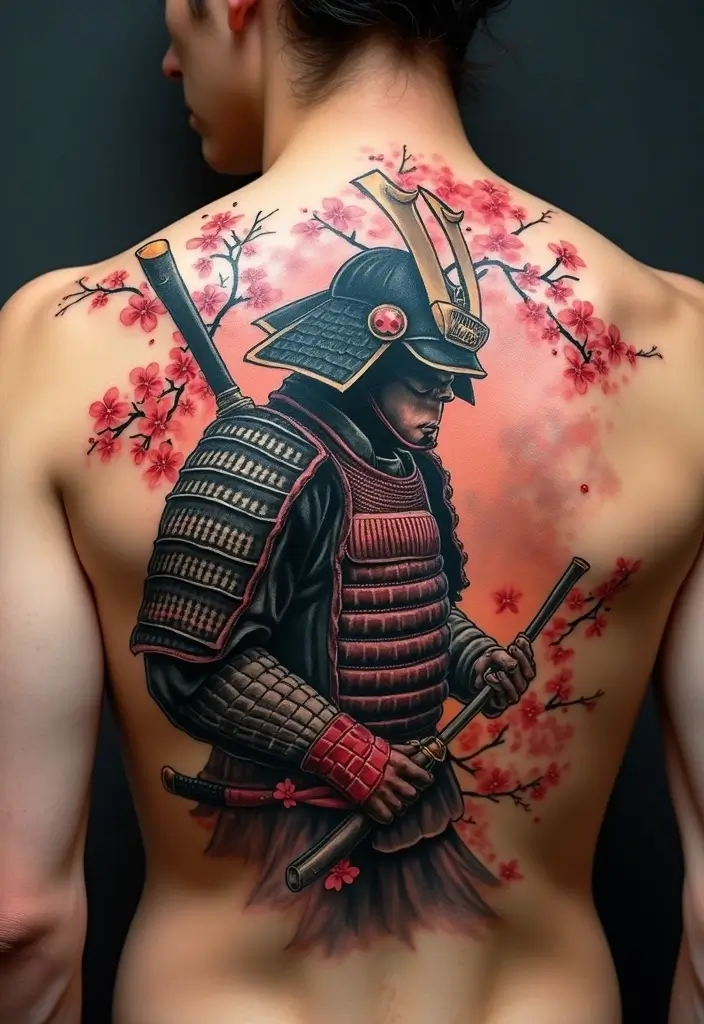
Combining samurai and cherry blossoms creates a powerful tattoo representing strength and beauty. The samurai embodies honor and courage, while the cherry blossoms symbolize the transient nature of life. This combination can tell a comprehensive story of the balance between power and fragility in the human experience.
When considering this tattoo, ideal placement would be across the chest or back for a dramatic effect. To keep your skin as vibrant as the tattoo, focus on a skincare routine that emphasizes both hydration and protection from the sun, ensuring your skin glows alongside your ink.
Skincare tips include:
– Regular SPF: Use sun protection to maintain tattoo vibrancy.
– Hydrating Lotions: Employ products that enhance moisture retention.
– Dietary Focus: Incorporate foods rich in antioxidants.
With a samurai and cherry blossom tattoo, paired with glowing skin, you personify a blend of strength and beauty.
18. Wisteria: Elegance and Serenity
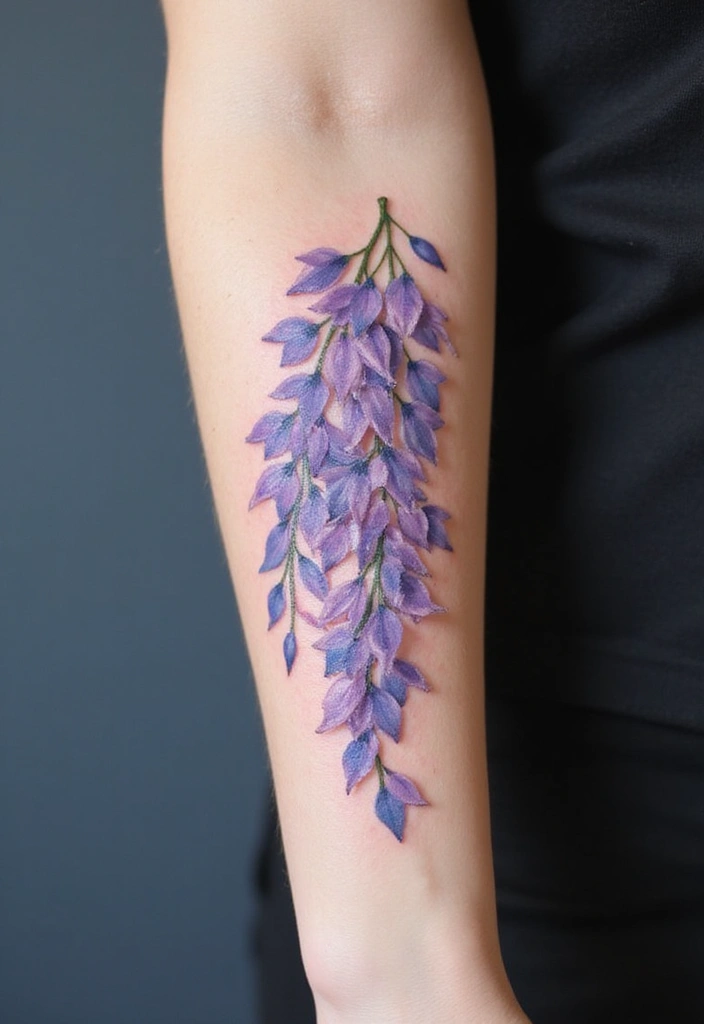
Wisteria flowers, known for their cascading beauty, represent elegance and serenity in Irezumi. These tattoos often depict long tendrils of wisteria hanging gracefully, creating an enchanting aesthetic. The soft purples and blues of wisteria tattoos can bring a calming aura, making them a favorite among those seeking a gentle yet impactful design.
For wisteria tattoos, consider positioning that allows for the flow of the design, such as on the arm or side. To keep your skin glowing alongside this delicate flower, implement a skincare routine that emphasizes hydration and calming properties, especially if you have sensitive skin.
Key skincare habits include:
– Calming Ingredients: Choose products with calming botanicals.
– Hydration: Maintain a consistent hydration routine.
– Gentle Cleanser: Opt for a cleanser that doesn’t irritate the skin.
With a wisteria tattoo and glowing skin, you embody elegance intertwined with serenity.
19. Butterfly: Transformation and Beauty

Butterflies are a universal symbol of transformation and beauty, making them a striking choice for tattoo enthusiasts. In Irezumi culture, butterfly tattoos often represent new beginnings and personal growth. The vibrant colors and delicate wings can echo a sense of freedom and inner beauty.
When planning a butterfly tattoo, consider incorporating elements like flowers or waves to enhance the design. Pairing such a beautiful tattoo with skincare habits that focus on renewal can elevate your entire look. Regular use of exfoliants and nourishing oils can help maintain a luminous complexion to complement your butterfly.
Here’s how to nurture your skin:
– Exfoliation: Regular exfoliation promotes cell turnover.
– Nourishing Oils: Use oils that deeply penetrate and hydrate.
– Antioxidant-Rich Diet: Consume foods that promote skin health.
With a butterfly tattoo and radiant skin, you celebrate the beauty of transformation.
In the world of Irezumi, a butterfly tattoo is more than just art; it’s a celebration of transformation and personal growth. Embrace your journey and let your tattoo reflect the beauty within you!
20. Hummingbird: Joy and Resilience
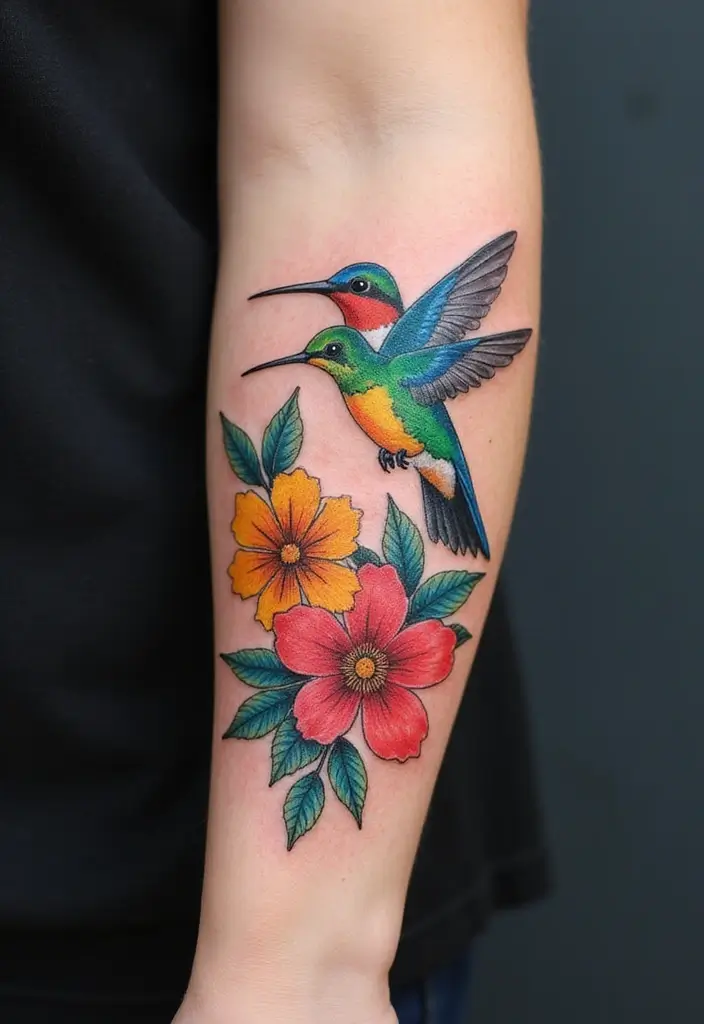
Hummingbirds represent joy, resilience, and the ability to focus on the positive aspects of life. Their vibrant colors and quick movements embody energy and vitality, making them a joyful tattoo choice. A hummingbird tattoo can symbolize the pursuit of happiness and the beauty of living in the moment.
When considering a hummingbird tattoo, think about how it can be surrounded by flowers or other elements to create a cheerful scene. To keep your skin vibrant, integrate daily habits that promote radiance, like using brightening creams or serums.
Here are some skincare routines to maintain that joyful glow:
– Brightening Products: Look for ingredients like niacinamide for enhanced radiance.
– Hydration: Stay hydrated internally and externally.
– Moisturizing: Always finish your routine with a hydrating cream.
With a hummingbird tattoo and glowing skin, you exemplify joy and resilience.
Embrace the hummingbird spirit! Life’s fleeting moments are best celebrated with joy and resilience – let your tattoo reflect your vibrant journey. Surround it with blooms to capture the beauty of living in the now!
21. Family Crests: Heritage and Identity

Family crests are rich in meaning, representing heritage and identity. Irezumi tattoos often incorporate elements of family symbols, connecting individuals to their roots and ancestral history. A family crest tattoo can be both a personal and cultural statement, celebrating the legacy of one’s lineage.
When considering a family crest tattoo, placement can be significant; think about areas close to the heart, such as the chest or back. To complement the significance of your tattoo, focus on skincare routines that nourish and protect your skin, as a healthy complexion reflects a connection to your roots.
Here are some skincare tips to enhance your natural beauty:
– Protective Products: Use creams that shield your skin from environmental stressors.
– Hydration: Maintain hydration to keep skin supple.
– Regular Care: Stay consistent with your skincare routine for the best results.
With a family crest tattoo and glowing skin, you embrace your identity and heritage.
22. Sumo Wrestler: Strength and Skill

Sumo wrestlers symbolize strength, skill, and dedication in Japanese culture. A sumo wrestler tattoo can represent not only physical prowess but also the mental and spiritual discipline required in the sport. These tattoos often depict wrestlers in action, showcasing their powerful build and dynamic poses.
When getting a sumo wrestler tattoo, consider placements that can highlight the muscular form, such as the arm or chest. Pairing this bold image with a skincare routine aimed at maintaining skin health, particularly post-workout, can enhance your overall appearance. Regular cleansing and moisturizing after exercise ensure that your skin remains vibrant and smooth.
Here’s how to care for your skin:
– Post-Workout Cleansing: Cleanse sweat and impurities immediately.
– Hydrating Products: Use lightweight moisturizers that absorb quickly.
– Sun Protection: Never skip SPF to avoid damage.
With a sumo wrestler tattoo and cared-for skin, you embody strength and dedication.
23. Bamboo: Resilience and Flexibility
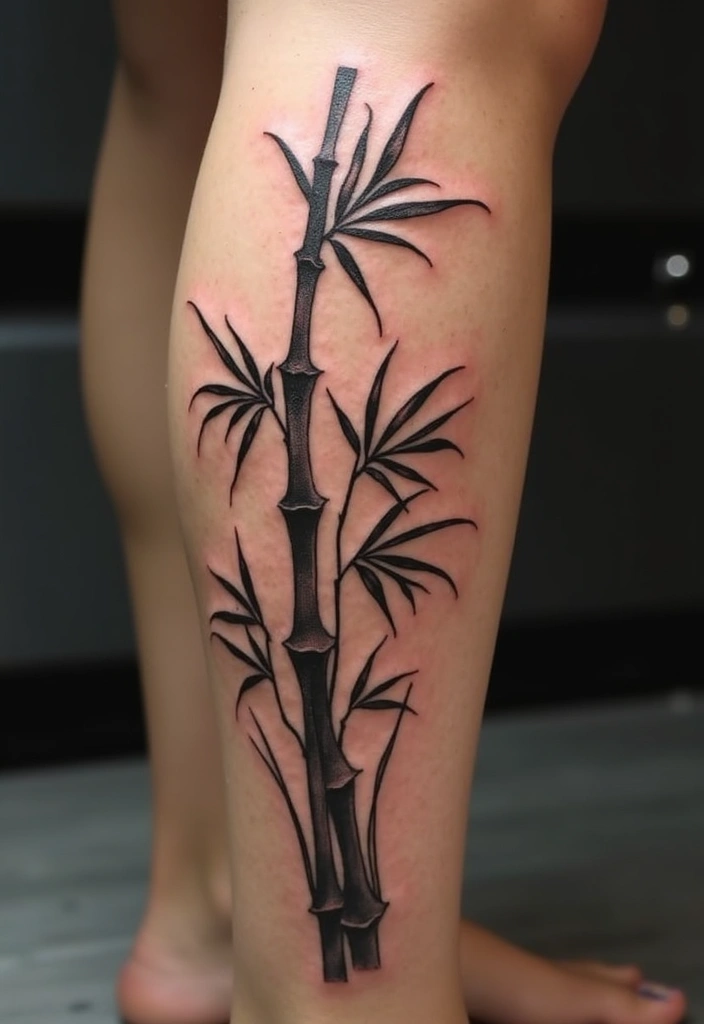
Bamboo represents resilience and flexibility in Japanese culture, making it an inspiring tattoo choice. Bamboo tattoos often feature intricate designs that emphasize the plant’s natural beauty and strength. This tattoo symbolizes adaptability and personal growth, resonating with many who value these traits.
For a bamboo tattoo, consider placements that allow for flow and movement, such as the arm or leg. To keep your skin as resilient as your tattoo, implement a skincare routine that focuses on protection and hydration. Incorporating products that strengthen your skin barrier can be beneficial.
Key skincare habits include:
– Strengthening Creams: Use products that support the skin barrier.
– Hydration: Drink water and use hydrating serums daily.
– Regular Masks: Nourish your skin with hydrating masks weekly.
A bamboo tattoo paired with glowing skin reflects the beauty of resilience.
24. Pagoda: Spirituality and Tradition
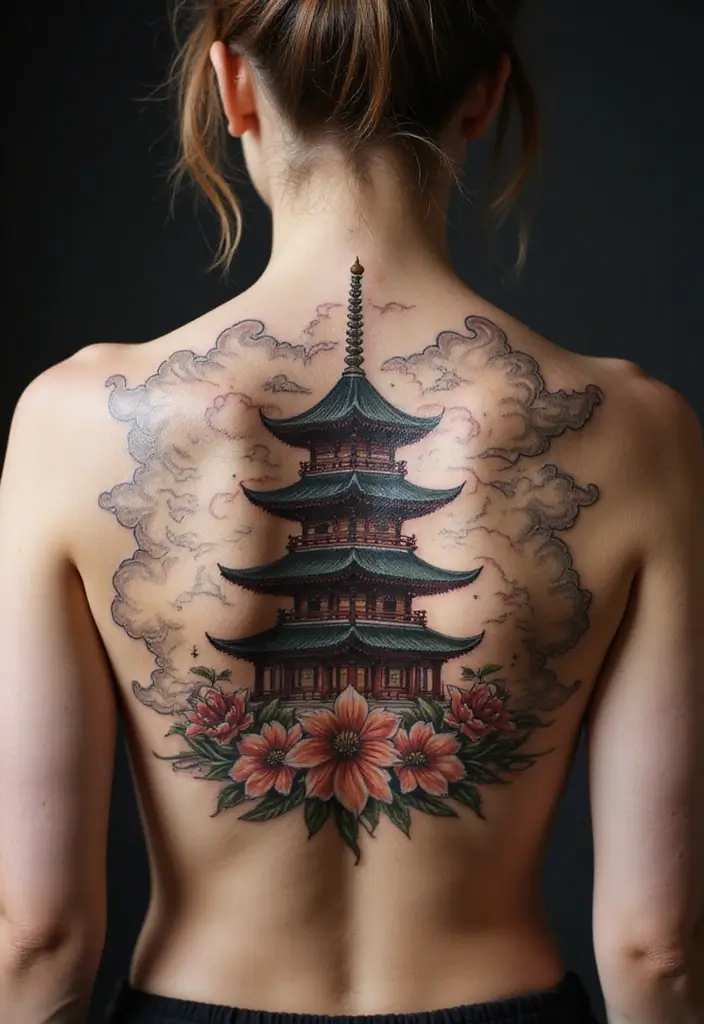
Pagodas are a symbol of spirituality and tradition in Japanese culture, often representing a sense of peace and connection to the divine. A pagoda tattoo can serve as a personal reminder of one’s spiritual journey and beliefs. The intricate architectural details of pagoda tattoos make them visually stunning and meaningful.
When considering a pagoda tattoo, think about incorporating elements like clouds or cherry blossoms to enhance the design. To keep your skin healthy and glowing, maintain a skincare routine that emphasizes nourishment and hydration. Products rich in natural extracts can help enhance your complexion.
Skincare tips include:
– Natural Extracts: Utilize products with botanical ingredients for nourishment.
– Hydration: Stay hydrated for skin elasticity.
– Consistent Routine: Keep up with a daily skincare regimen.
A pagoda tattoo and radiant skin embody spirituality and beauty.
25. Dragonfly: Change and New Beginnings

Dragonflies symbolize change and new beginnings, making them a meaningful tattoo choice in Irezumi art. Often depicted in vibrant colors, dragonflies can represent the lightness of being and the ability to adapt to life’s transformations. This tattoo can resonate deeply with those who value growth and renewal in their lives.
When planning a dragonfly tattoo, consider placements that allow for a delicate yet striking look, such as the ankle or wrist. To maintain skin health alongside your dragonfly tattoo, implement skincare routines that focus on moisture and protection. Using lightweight products that hydrate can keep your skin soft and glowing.
Here’s how to ensure your skin stays vibrant:
– Lightweight Moisturizers: Use formulas that hydrate without feeling heavy.
– Regular Hydration: Drink plenty of water throughout the day.
– Sun Protection: Always apply sunscreen before going out.
With a dragonfly tattoo and glowing skin, you embrace the beauty of change.
Embrace the beauty of change! A dragonfly tattoo in Irezumi art represents new beginnings—perfect for those ready to grow and adapt. Where will your transformation take you?
26. Silverfish: Anticipation and Change
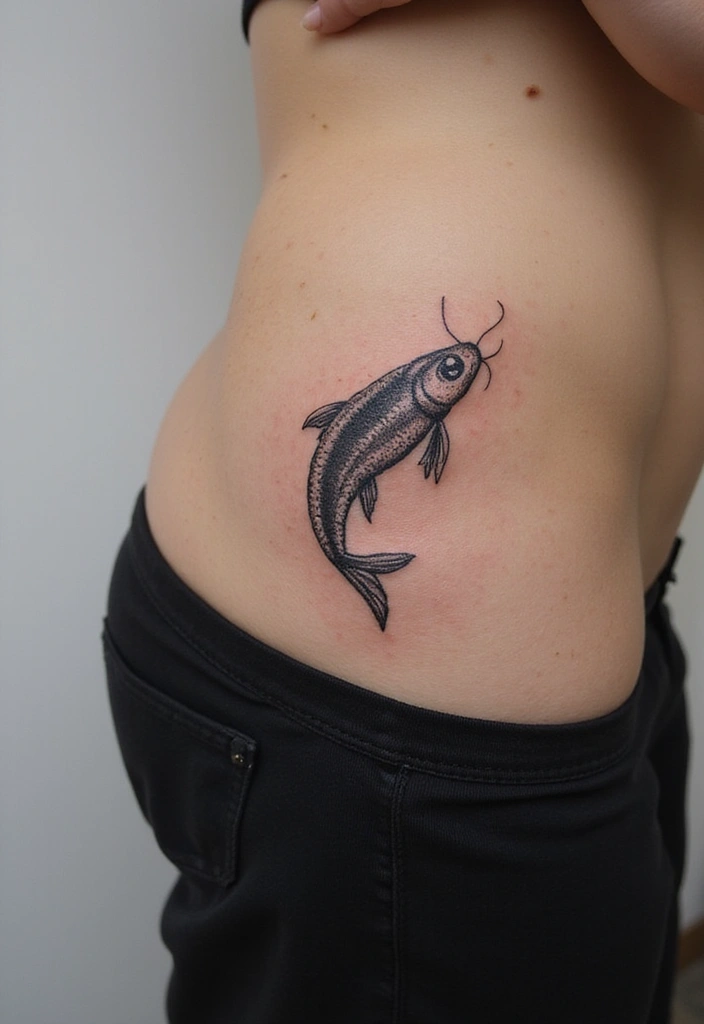
Silverfish tattoos symbolize anticipation and change, reflecting the qualities of adaptability. Often illustrated in sleek, dynamic lines, these tattoos can embody a sense of movement and fluidity, making them a unique choice for those who appreciate a different perspective on life’s transitions.
When considering a silverfish tattoo, focus on placements that allow for flow, like the side or back of the arm. To keep your skin radiant, cultivate a skincare routine that emphasizes hydration and renewal, particularly if you have sensitive skin. Integrating soothing ingredients into your products can enhance your skin’s glow.
Here are skincare tips to keep in mind:
– Soothing Ingredients: Opt for products with chamomile or aloe.
– Regular Hydration: Drink plenty of water to support skin health.
– Gentle Exfoliation: Use mild exfoliants to keep your skin fresh.
With a silverfish tattoo and soft skin, you embody the anticipation of change.
27. Calligraphy: Art of Expression
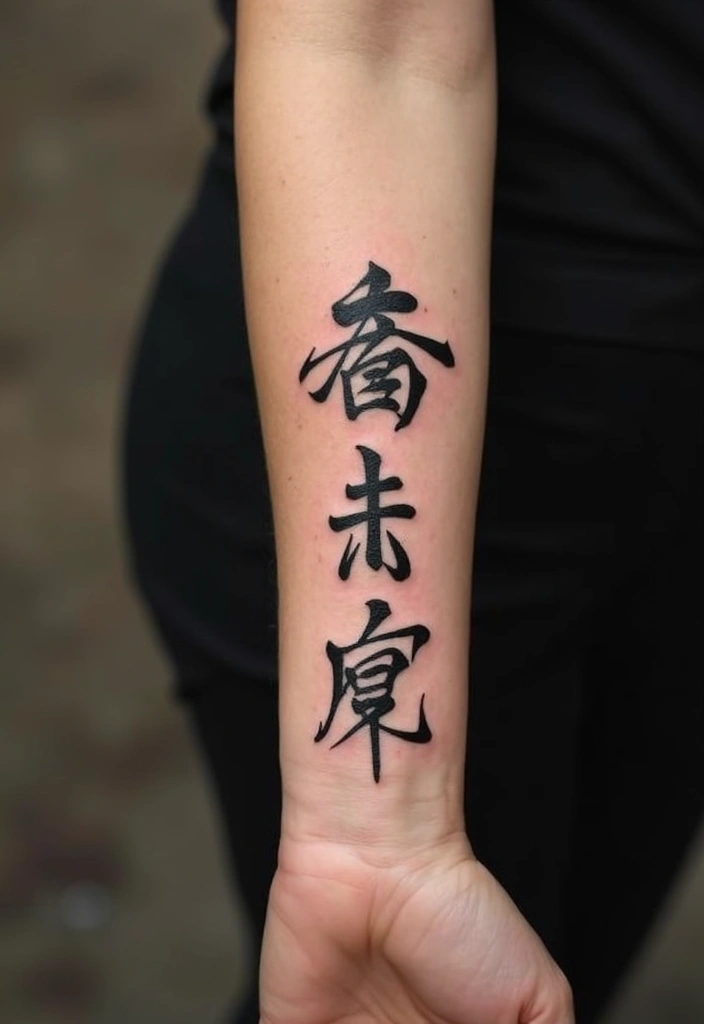
Japanese calligraphy tattoos capture the art of expression and language, often featuring powerful kanji symbols that convey deep meanings. This form of tattooing honors the beauty of written language, making it a personal and artistic choice. Calligraphy tattoos can represent values, names, or personal mantras.
When considering a calligraphy tattoo, placement is key; think about areas where the flow of the text can be fully appreciated, such as the forearm or back. To keep your skin looking its best, maintain a skincare routine that focuses on hydration and protection, ensuring the ink remains vibrant.
Key skincare practices include:
– Moisturizing: Use rich creams to protect your skin.
– Gentle Cleansing: Ensure your skin is clean without harsh ingredients.
– Regular Care: Stick to a consistent skincare regimen.
With a calligraphy tattoo and glowing skin, you celebrate the art of personal expression.
28. Ginkgo Leaves: Resilience and Strength
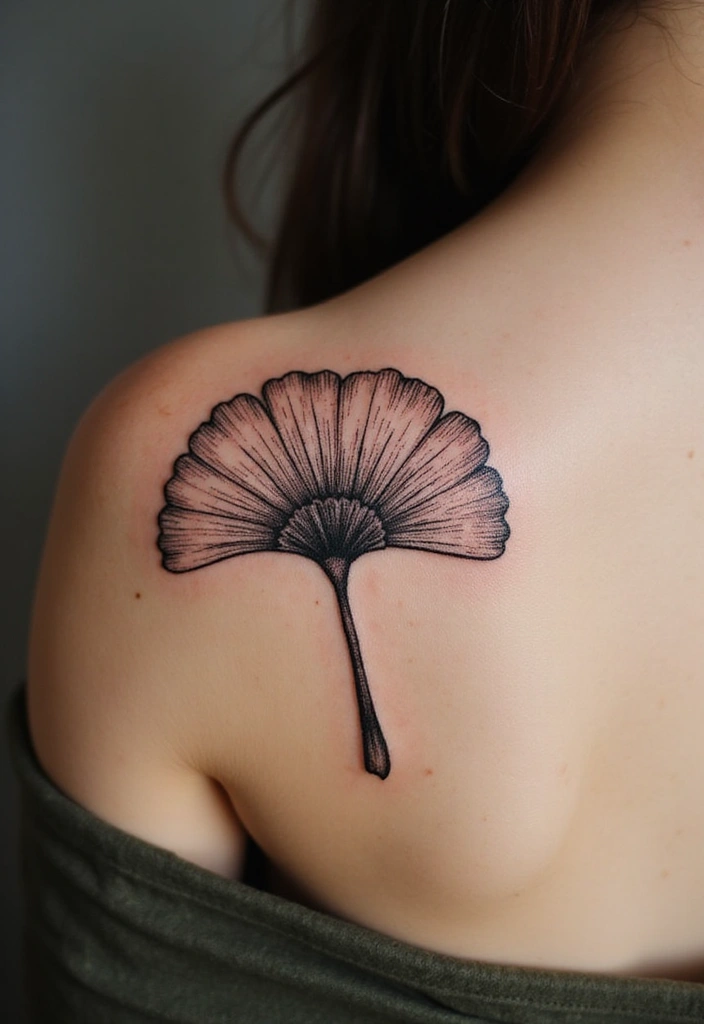
Ginkgo leaves are a symbol of resilience and strength, representing the ability to endure and thrive. In Irezumi tattoos, ginkgo leaves can be depicted in various styles, from delicate to bold, and often accompany other elements like waves or cherry blossoms. This tattoo can convey a sense of stability and lasting beauty amidst change.
When planning a ginkgo leaf tattoo, think about how the leaves can be arranged to enhance movement, perhaps flowing along the arm or shoulder. To maintain glowing skin alongside your tattoo, focus on a routine that emphasizes nourishment and hydration. Incorporating serums rich in vitamins can greatly enhance your skin’s appearance.
Here are some skincare tips to consider:
– Nourishing Products: Choose products that contain essential fatty acids.
– Hydration: Drink plenty of fluids to keep skin elastic.
– Sun Protection: Use sunscreen to prevent fading.
With a ginkgo leaf tattoo and radiant skin, you embody resilience and beauty.
29. Sun and Moon: Balance of Opposites
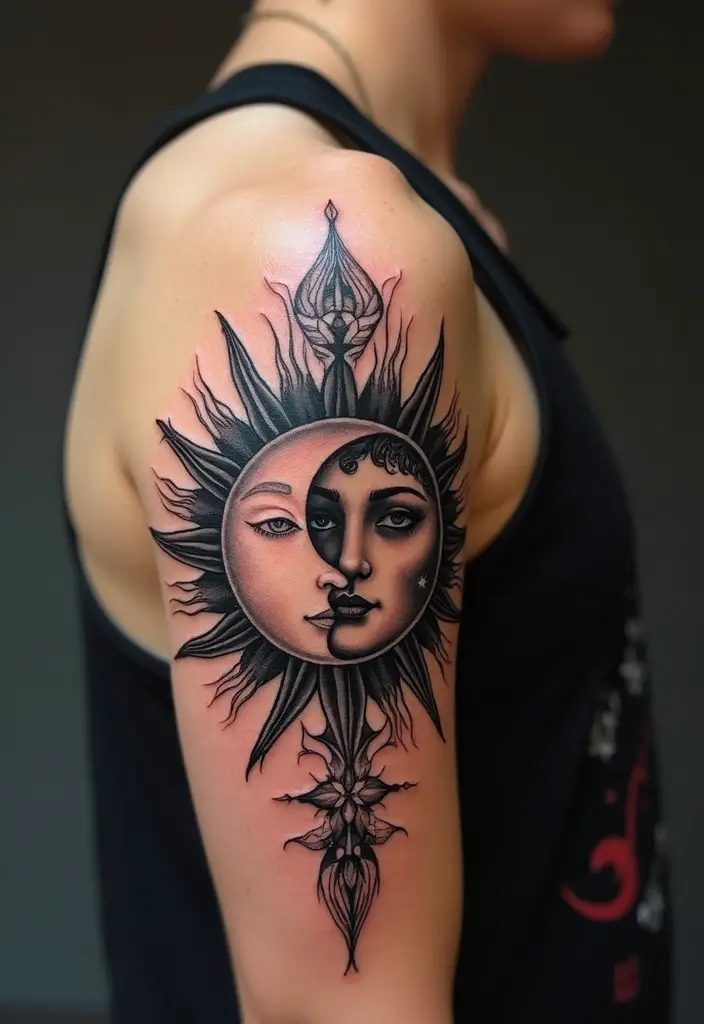
The sun and moon tattoos symbolize the balance between opposites – light and dark, day and night, life and death. This duality can create a stunning design, often featuring intricate details that highlight the contrast and harmony between these celestial bodies. A sun and moon tattoo can represent the complexities of life and one’s personal journey.
When considering this tattoo, placements like the upper arm or back can effectively showcase the design’s depth. To keep your skin glowing alongside this meaningful tattoo, invest time in a skincare regimen that promotes balance and hydration. This includes using products rich in antioxidants to protect your skin.
Key skincare practices include:
– Antioxidant-Rich Products: Use creams and serums that protect against environmental damage.
– Daily Sunscreen: Always wear sunscreen to maintain skin health.
– Hydrating Routine: Incorporate hydrating mists throughout the day.
With a sun and moon tattoo and radiant skin, you express the balance of life’s contrasts.
30. Yin Yang: The Harmony of Opposites
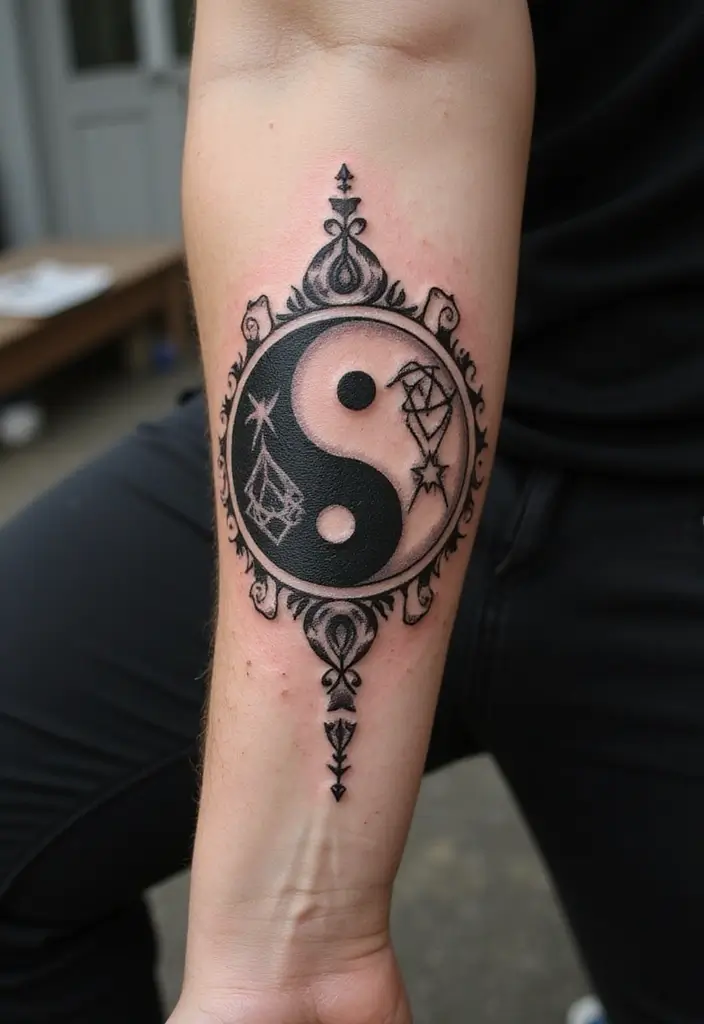
Yin Yang tattoos embody the concept of harmony and balance between opposites. This ancient symbol represents the interconnectedness of light and dark, good and evil, and all elements of life that rely on each other. A Yin Yang tattoo is a beautiful way to express the importance of balance in one’s life.
When planning a Yin Yang design, consider how it can be incorporated into larger pieces or surrounded by elements like lotus flowers or waves. To maintain glowing skin that complements your tattoo, adopt a regimen that emphasizes balance, incorporating both hydrating and nourishing products.
Here’s how to keep your skin healthy:
– Balanced Skincare Routine: Use a combination of hydrating and treatment products.
– Healthy Diet: Emphasize a diet rich in antioxidants and hydration.
– Sun Protection: Always protect your skin from the sun.
With a Yin Yang tattoo and luminous skin, you represent the essence of balance and beauty.
Conclusion
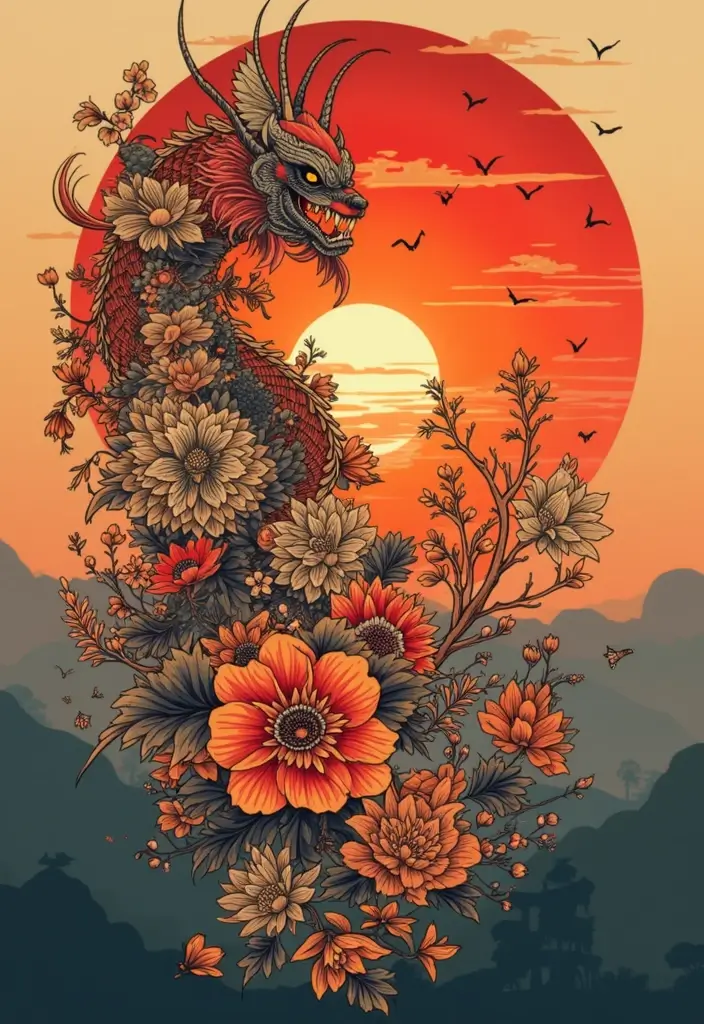
Irezumi tattoos are more than just beautiful body art; they encapsulate stories, traditions, and personal meanings. Each design holds a connection to Japanese culture, representing various values and aspects of life. As you explore these designs, remember that your skincare routine can enhance both the beauty of your tattoo and your skin’s radiance. Embracing daily habits that nourish and protect your skin alongside your ink can create a harmonious balance that celebrates both art and beauty.
Explore the world of Irezumi tattoos and let your skin glow as vibrantly as the stories they tell.
Frequently Asked Questions
What Is Irezumi and How Is It Different from Other Tattoo Styles?
Irezumi is a traditional Japanese tattoo art form that showcases intricate designs filled with vibrant colors and deep cultural significance. Unlike other tattoo styles, Irezumi often tells stories through its motifs, such as koi fish symbolizing perseverance or dragons representing power and wisdom.
These tattoos are not just body art; they reflect a rich history and philosophy, making them unique in the tattoo world.
Are Irezumi Tattoos Painful to Get?
The pain level of getting an Irezumi tattoo can vary depending on the design and the individual’s pain tolerance. Generally, due to the detailed and large-scale nature of Irezumi, the process may be more intense than smaller tattoos.
However, many enthusiasts find that the end result—a stunning piece of art—makes the discomfort worthwhile. Remember to choose a skilled artist who specializes in Irezumi for the best experience!
How Should I Care for My Irezumi Tattoo?
Caring for your Irezumi tattoo is crucial for ensuring it heals properly and maintains its vibrancy. Start by keeping it clean with mild soap and water, and avoid soaking it in water for extended periods.
Use a high-quality, fragrance-free moisturizer to keep the skin hydrated and promote healing. Additionally, protect your tattoo from direct sunlight to maintain its colors and prevent fading. Regular skincare habits will help you achieve that glowing skin you’re after!
What Are Some Popular Irezumi Tattoo Designs and Their Meanings?
Irezumi tattoos are rich with symbolism. Some popular designs include:
Koi Fish for perseverance, Cherry Blossoms for the beauty of life, and Dragons for power and wisdom. Each design tells a unique story, making them deeply personal choices for individuals. If you’re considering an Irezumi tattoo, think about what story or value resonates with you!
Can Irezumi Tattoos Be Covered Up or Altered?
Yes, Irezumi tattoos can be covered up or altered, but it requires careful planning. If you’re considering changing an existing tattoo, consult with a skilled tattoo artist who has experience in cover-up work. They can help you design a new piece that incorporates elements of the old tattoo while creating something fresh and new.
Remember, the goal is to maintain the artistry and meaning while enhancing your body art.

